East Slavic folklore and tales
Last active 60 minutes ago
Don't wanna be here? Send us removal request.
Text
Experimental USSR - Victory over the Sun
As much as I don't like the history of the 20th century (basically anything after WWI), I think stating that the early USSR was one of the most interesting countries in history wouldn't be an overstatement. One of the first countries that legalized gay marriage (taken away by Stalin later), literacy campaign (from 56% in 1916 to more than 80% in 1937), legalized abortions (undermined by Stalin), legalized divorce, providing maternity leave, equal rights, NEP... It was a bloody time, but a lot of things changed for the better for most people. I don't like the later USSR, but even then it still tried to provide good living conditions to most people. Central heating, housing, bathrooms in apartments, etc. Obviously, we can say a lot about how bad it was (for example, peasants didn't have passports until 1974, making the USSR a state with serfdom). But looking only at the bad things won't show us the full picture. This is why I want to talk about some experiments in the Soviet Union -cultural, social, and maybe even scientific. Today we will start with a play with costumes by none other than Malevich himself...
Victory over the sun.

"Victory Over the Sun" is an experimental opera staged in December 1913 at Luna Park in St. Petersburg. It was the result of collaboration between key figures of the Russian avant-garde: poet Alexei Kruchyonykh, composer Mikhail Matiushin, and artist Kazimir Malevich. They called themselves "budetlyani" (people of the future). The production was rooted in futurist ideas of radical departure from the past, a rejection of traditional art forms, and a drive to create something entirely new and unconventional.

The opera’s text was written by Alexei Kruchyonykh in a so-called "zaum" (smart-ass) language - a unique blend of sounds, words, and symbols meant to express new meanings detached from the logic and grammar of a conventional language. The Zaum language was intended as a way to break away from old literary and artistic canons, embodying the Futurist ambition of freeing art from its historical forms.

Mikhail Matiushin’s music was equally unconventional, far from traditional melodies and harmonies. It featured complex, dissonant, and unpredictable musical forms that challenged the audience's expectations of what an opera should sound like. The experimental use of dissonances and rhythms created an auditory landscape that heightened the futurist themes of the production. In this video, you can hear how it sounds.
Kazimir Malevich’s set designs and costumes became one of the most iconic aspects of the opera. Drawing inspiration from suprematism, Malevich rejected traditional depictions of space and reality. His stage design consisted of abstract geometric shapes that starkly contrasted with conventional theatrical art. The costumes were cubist and rectangular constructions, symbolizing mechanization and a rejection of the human figure.
Not only that but decorations were destroyed during the play. They were part of the play - not just a scenery. Here are some of the sketches of the costumes by Malevich. You can find more examples in this Wikipedia article.






The plot of Victory Over the Sun symbolizes futurism and modernism's triumph over the old world. In the opera, the Sun, representing the established order, is "captured" and caged by futurists who seek to destroy old norms and create a new world. The meaning was veiled and ambiguous, sparking debates and confusion among the audience. Some consider it science's victory over nature (you can somewhat compare it to a Dyson Sphere), while others thought that it dismantles the "Sun of Russian poetry - Pushkin.

The first performance caused an explosive reaction. The audience didn’t understand what was happening on stage - the libretto seemed absurd, the music cacophonous, and the set design too radical. The response was mixed, ranging from admiration to outright rejection. It was one of those moments when art challenged its viewers, offering a completely new aesthetic.
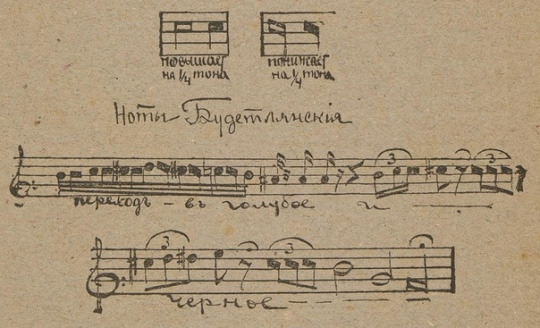
Victory Over the Sun had an impact on the development of avant-garde art, especially in Russia. It was during the work on this opera that Kazimir Malevich created the first version of his famous Black Square - a symbol of suprematism.
#history#vseslavichi#art#theatre#musical theater#suprematism#kazimir malevich#futurism#ussr#ussr history#culture#20th century
3 notes
·
View notes
Text
About the equality in the USSR... During the interbellum period, there were a lot of media that promoted main goals of the communist party and state. One of those was freeing women from domestic servitude. But activists were often only willing to support slogans in words, while in practice, they refused to acknowledge the objective reality of the burden of domestic labor. I want to share a small part of Vladimir Varankin's novel "Metropolitan", where the bachelor communist Ivagin argues with his comrade's wife, who has fled to the countryside to escape the domestic servitude of city life (there she was able to find a job for the first time):
– I'm starting to fear you!
– Why?
– You’re already sending me to stand in line! On May 1st, I did all your errands, carried the kids, moved the decorations behind the stage during the children's celebration, hammered nails. Your daughter rides on my shoulders! And in the end... – he waved his hand.
– What, in the end? — Olga asked, not understanding.
– In the end, I'll never get married! You've completely discouraged me!
Olga laughed.
– And what did you expect? You’ll build socialism, and your wife will just look after the children and stand in line? Or maybe you’d prefer it the other way around? After all, someone has to do it!
– Why a man?
– Why a woman?
Can't lie, it is an entertaining read. Some of the points that the author makes can still be used today.
2 notes
·
View notes
Text
Saints aren't nice - Paraskeva Pyatnitsa
Nearly all cultures were affected by their religion. Often by just knowing the religion of the country, you can guess some things that are valued in this society. And it isn't different in Russia. Orthodox Christianity made suffering one of the cornerstones of my culture. I would say that enduring hardships could be a national sport...

Anyway, Orthodox Christianity is rich in a lot of weird saints. Most of them are mixed with old, pagan, beliefs. And today's "guest" isn't an exception. Paraskeva Pyatnitsa can be considered part of the Slavic folklore, combining elements of Christian sainthood with remnants of pagan beliefs. Revered among Orthodox Slavs, she is based on both Saints Paraskeva of Iconium and Paraskeva of Serbia. However, in folk traditions, her role goes beyond Christianity, reflecting aspects of the pagan goddess Mokosh, who was linked to women’s work, fertility, and protection of the household.


Paraskeva became the personification of Friday, a day considered sacred and often tied to prohibitions around spinning, washing, and other household tasks. Those who disrespected these rules were believed to face her wrath, with punishments including illness, blindness, and flaying.
Russians prayed to Paraskeva Pyatnitsa for protection from the death of livestock, especially cows. The saint was also considered a healer of human ailments, especially the devil‘s obsession, fever, toothache, headache, and other diseases. In honor of Saint Paraskeva, there were special prayers worn around the neck and considered to be a protection against various diseases. Flowers, herbs, and other attachments to the image of Paraskeva-Patnitsa were also considered to be one of the most effective medical remedies and therefore were preserved from year to year as an important healing aid. In case of any illness, peasants boiled them in water and used this decoction to drink for various diseases.

In addition to her religious significance, Paraskeva’s folk image is both protective and fearsome. While traditional icons depict her as an ascetic figure in a red cloak, folk stories paint a wilder picture - showing her as a tall woman with loose hair and large breasts, a blend of both nurturing and punishing forces. In some regions, rituals like vodit' (lead) Pyatnitsu involved leading a woman dressed as the saint around the village, seeking her blessing for the harvest or livestock.

This blending of Christian and pagan elements made Paraskeva an important figure in both religious and rural life. Her feast days, especially October 14 (October 27, New Style), were celebrated with church services and the observance of traditional bans on work, particularly among women. In some regions, Paraskeva was also connected to the "12 Fridays" legend, marking sacred Fridays throughout the year for fasting and reflection. Some authors consider the echo of the Slavic pre-Christian beliefs some authors consider ‘idol’ sculptural images of saints preserved in some places even in the XIX - early XX centuries. The most frequent was the sculpture of Paraskeva Pyatnitsa. In Russia, her wooden sculptures were widespread - ‘wooden painted statue of Friday, sometimes in the form of a woman in oriental garb, and sometimes in the form of a simple woman in a ponyova and lapti’. The statue of Paraskeva ‘was placed in churches in special boxes and people prayed before this idol’.

Ultimately, this is one of the saints who is more like a minor pagan deity - she will punish you if you don't follow her rules, but she also can protect you from illness.
#history#vseslavichi#mythology#mythology and folklore#folklore#slavic folklore#slavic mythology#mystical creatures#slavicmythology#slavicfolklore
12 notes
·
View notes
Text
Alexei Remizov - modernist storyteller
Alexey Mikhailovich Remizov was one of the brightest and most original figures in early 20th-century Russian literature, known for his experiments with language, his mythological thinking, and his interest in folk tales. Born in 1877 in Moscow, he was not only a writer but also an artist, which is reflected in his vivid and symbolic prose.

Remizov's work is filled with mysticism, fantasy, and a deep exploration of the human soul. His style is often described as "skaz" - he actively used folk motifs and idiomatic expressions. One of his most famous collections, "Posolon", demonstrates this blend. In it, Remizov merges myth and reality, drawing readers into a world where the line between the visible and the invisible is blurred:
People believe in the old, but the old is not what it seems! It was and will be something else - neither God nor man can understand it.

Remizov was also fascinated by medieval Russian culture and ancient chronicles. His works, such as "Limonar", are steeped in archaic language and reflect his attempts to revive spiritual traditions. In this piece, he draws on biblical themes and Christian philosophy:
"Every word is like a seed — you plant it, and it grows, bearing fruit. But that fruit is for the soul, not for worldly desires."

Remizov often experimented with form and language, breaking traditional narrative conventions. His prose is filled with rhythm and recurring motifs, creating a chant-like effect. An example is "The Word of the Ruin of the Russian Land", where he describes historical catastrophes from a metaphysical perspective:
"Ruin is not in what happened, but in the fact that the people lost their soul — and without a soul, there is no land."
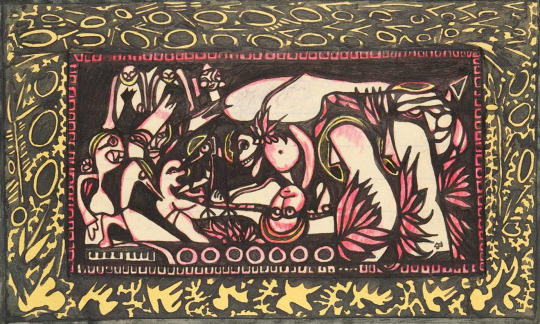
His tales are an interesting blend of modern and old. There is a lot more to him other than his books, but they are the most important heritage he left.
With his rich literary legacy, several works stand out for their depth and uniqueness:
"Posolon" (1907) This collection of folk tales is one of Remizov's best-known works. In it, he masterfully uses fairy-tale elements, intertwining them with mythology and fantasy. At the center of the narrative are Russian folk stories, reimagined through the lens of symbolism and metaphorical language. Posolon captivates with the way it blurs the lines between reality and fantasy, and the narrative takes on a hypnotic rhythm that immerses the reader in an ancient and mystical world. This work is worth reading for its unique language and its ability to bring folk motifs to life.
"Limonar" (1911) In this collection, Remizov explores Christian and biblical themes, through which the human soul and its aspirations are revealed. Limonar is notable for its archaic form, reminiscent of ancient Russian chronicles and Christian didactic texts. The work attracts with its deep spirituality and the author's attempts to delve into eternal questions of faith and existence. It is a must-read for those interested in religious philosophy and medieval themes presented through an unusual authorial interpretation.
Unfortunately, it seems there are no translations of his works into English...
#history#vseslavichi#mythology and folklore#slavic folklore#slavic mythology#literature#literary quotes#literary fiction
7 notes
·
View notes
Text
A not-so-short absence...
Unfortunately, I have been busy lately. First, I got a job at a company I always wanted to work for. Interviews, onboarding, and all that jazz took quite some time. Second, I was solving a logistical nightmare of delivering 18-string gusli from Russia to Serbia. And it is kinda hard to pick a musical instrument when you have never played any.
Third, I was re-evaluating my posts. At the moment nearly all of them are about mythological creatures, but I wanted to share more historical facts and information. This is why I will change the schedule of posts a bit - 1 will be about mythology, 1 about history, and 1 will either be about my story or it will somehow involve both history and myths.
For this week, I have prepared three posts:
Impressionist, modernist, and storyteller. Quoting Kuprin: "He does not imagine the phenomena of real-life except through some ominous, ugly, fantastic and mysterious glass…. He is sincere to the point of naivety, he conjures, whispers, whispers and babbles strange frightening words with complete unbreakable faith…". His books might be interesting if you want to dive into the fairytales of a Russian author from the early to mid-20th century.
A saint, who could flay you if you spin threads on Friday. Mokosh of Orthodox Christianity.
Futuristic Opera from 1913. With costumes by none other than Malevich.
Overall work on the main part of the project goes slower than I expected. Because I was too naive to believe an artist who wanted 100% payment in advance. Never ever do this. Even if this person was recommended to you.
#vseslavichi#history#mythology#mythology and folklore#folklore#mystical creatures#slavic folklore#slavic mythology#slavicmythology#slavicfolklore#traditional music#musical instruments#music
0 notes
Text
Vasilisa Mikulishna - my favorite bogatyr
I will be honest with you - strong women are my weak spot. And I don't mean only physically - but in their principles, intelligence and maturity. In my childhood, I had several favorite characters - some wre obviously male, but among my top three would be two femalre heroines - one is Mulan and about the other one I want to talk today. People who are familiar with Slavic and Russian folklore knowabout Bogatyrs. Bogatyrs are the mighty warrior heroes known for their strength, bravery, and unwavering loyalty. These legendary knights, like Ilya Muromets and Dobrynya Nikitich, are celebrated for their heroic deeds and battles against evil forces. But less people know about their female counterparts who not only in no way inferior, but often even superior to their male peers. Among these legendary heroines, one stands out for me - Vasilisa Mikulishna.

Tale of Vasilisa Mikulishna
Vasilisa Mikulishna is dughter of Mikula Selyanovich - a bogatry known for his principle that you can wield power, but you shouldn't use it until it is necessary. She is celebrated as a clever and daring heroine. Vasilisa is wife of Stavr Godinovich, a nobleman who boasts of her intelligence and beauty, claiming she could outwit the mightiest of men. When Stavr’s pride lands him in trouble, leading to his imprisonment by prince Vladimir, Vasilisa decides to take matters into her own hands.
Disguising herself as a young warrior, Vasilisa dons armor and rides to Kiev, the capital, where she introduces herself as a foreigner (in one version - as a Tatar ambassador, in another - Polish prince). Her wit and wisdom quickly capture the attention of Prince Vladimir, who challenges her to various tests of strength and intellect. Vasilisa excels in each challenge, proving her abilities and earning the prince’s respect.

Rescue
The highlight of Vasilisa Mikulishna’s tale is her ingenious rescue of Stavr. There are two versions of what happens nest. In the first one, after impressing Prince Vladimir, she reveals her true identity and demands her husband’s release. Vladimir, impressed by her bravery and loyalty, grants her request. Vasilisa’s actions demonstrate not only her physical prowess but also her intelligence and strategic thinking, traits that set her apart in the world of Slavic folklore. In another one, Vasilisa misleads him, demands Zabava Putyatichna as her wife, and at the wedding feast this "Tatar ambassador" says that "court gusliars are bad" and demands to bring Stavr. She takes Stavr with her, leaves and then reveals herself to her husband, after which Vasilisa and Stavr go to Chernigov (or to Lithuania - in another version).
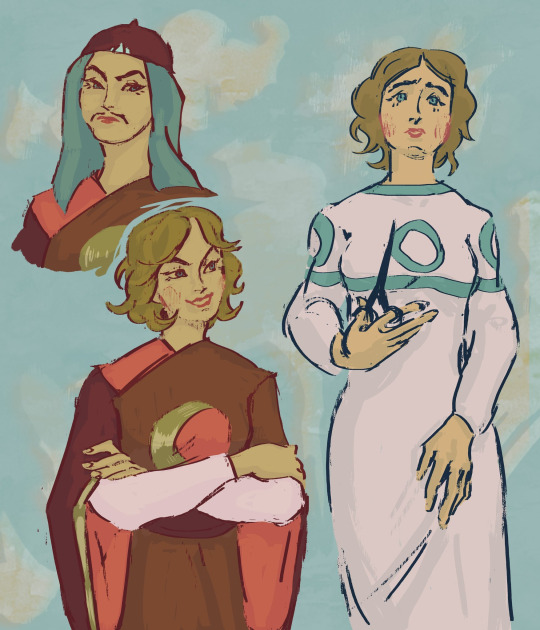
A Symbol of Strength and Wisdom
Vasilisa Mikulishna is more than just a warrior - she embodies the spirit of resourcefulness, loyalty, and equality. While being strong, she doesn't use brute force to save her husband and uses her wit to outsmart Kievan prince.
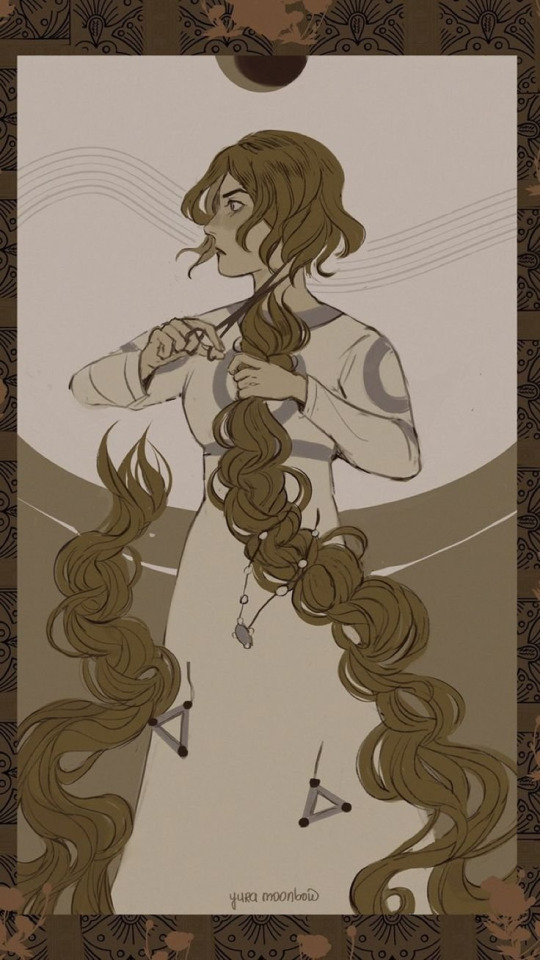
There is also a Soviet animation about this legend. It is somewhat good.
youtube
Also, if you know the artists of some of the pictures above - I would be grateful for the link! I couldn't tack those images :(
#history#mythology#vseslavichi#mythology and folklore#folklore#slavic mythology#slavicmythology#slavic folklore#slavicfolklore#heroine#female characters#strong women#Youtube
10 notes
·
View notes
Text
Gusli - traditional slavic folklore instrument
Gusli is a traditional stringed instrument, with its origins dating back over a thousand years. Resembling a small harp or zither, gusli typically features a flat, wing-shaped wooden body with multiple strings.

Historically, gusli were played by guslars, bards of Slavic societies, who used it to accompany epic tales and songs during feasts and ceremonies. There are several types of gusli, including the wing-shaped, helmet-shaped, and table versions, each offering unique sounds.

One of the most famous tales involving the Gusli is the legend of Sadko, a skilled musician who played the Gusli so beautifully that he enchanted the Sea Tsar. Sadko’s music was said to calm the waters and charm even the creatures of the deep, giving him riches and kickstarting his career as a merchant. Here is an example of one of my favorite soundtrack from Heroes of Might and Magic IV played on gusli (by Tamara Ivanova):
youtube
4 notes
·
View notes
Text
Gentle guardians of the forest - Gaevki
The forest is not only home to the fearsome Leshy but also to his more benevolent and protective descendants - Gaevki. These spirits, often described as the granddaughters of the Leshy, play an important role in maintaining the balance of nature within the woods.

Who are Gaevki?
Gaevki (гаёвки) are forest spirits known for their protective nature towards animals and the forest itself. They are depicted as young, delicate beings who embody the gentler aspects of the woodland. Unlike the more fearsome Leshy, Gaevki are not malevolent - they are spirits who watch over the forest’s inhabitants, ensuring that the balance of nature is preserved.
Appearance and behavior
Gaevki are often described as beautiful, ethereal young women. During the winter months, they are said to grow thick, white fur to blend in with the snowy landscape, shedding it in the spring when the forest comes back to life. Despite their gentle nature, they are known for their mischievous attitude, particularly when it comes to human visitors in the forest.
One of their most famous pranks involves stealing the clothes of young women who wander into the woods, forcing them to return home embarrassed. However, this trick is usually harmless.

Role in the forest
Gaevki are seen as the caretakers of the forest’s animals. They ensure that the creatures of the woods are protected and that the natural order is maintained. In Belarusian folklore, Gaevki are particularly close to the Leshy, often assisting him in his duties as the ruler of the forest. They might guide lost animals back to safety or help heal injured creatures.
Unlike the Leshy, who can be a dangerous trickster, Gaevki are more likely to help humans who show respect for the forest. They might lead a lost traveler back to the path or protect them from the more dangerous spirits that roam the woods.
Gaevki and the seasons
During the winter, when the forest is at its most vulnerable, Gaevki are believed to be especially vigilant. They protect the animals from the harsh cold and ensure that the forest remains a sanctuary even in the most challenging conditions.
Gaevki in regional folklore
In Belarus, Gaevki are well-known figures, closely associated with the deep, ancient forests. They are often linked to the concept of the "пуще" (pusche), or the untouched, primeval woods where nature reigns supreme. These spirits are considered protectors of the forest’s purity, ensuring that it remains unspoiled by human hands.
In Western Russia, Gaevki are sometimes seen as more playful spirits, reflecting the lighter side of the natural world. They might be involved in games with other forest creatures or even engage in friendly interactions with humans, as long as the latter show proper respect for the forest.
Gentle guardians
Gaevki may lack the imposing presence of the Leshy, but they are no less significant in Slavic spirit world. Their role as protectors of the forest and its creatures highlights the importance of balance in nature.
The Gaevki show us that the forest is not just a place of danger and mystery but also one of beauty, life, and gentle care.
#history#mythology#vseslavichi#mythology and folklore#folklore#mystical creatures#forest spirits#forest#nature spirits#spirits#slavicfolklore#slavicmythology#slavic folklore#slavic mythology
5 notes
·
View notes
Text
First steps - character concepts and art
Well, I found an awesome artist and started throwing money at him so he would make me character art. The first art I decided to get is for Lilia - life mage, backend lead, CrossFit sportswoman, and reenactor. Once her art is complete, I will make a post about her, including her background and where she stands at the beginning of her story. Also, the headband will go, cause it is a bit too much for a contemporary setting. But maybe some additional decorations related to her origin might appear.

2 notes
·
View notes
Text
Leshy - So, what then is my name to you?
Leshy has a lot of names - not only in Slavic countries but even in Russia! Here are some of them...

#meme#history#mythology#vseslavichi#mythology and folklore#folklore#mystical creatures#slavicfolklore#slavicmythology#slavic folklore#slavic mythology
2 notes
·
View notes
Text
Zazovki: Lures of the forest
In the deep, mysterious forests, not all spirits are benign or merely mischievous. The Zazovki are some of the most dangerous and alluring spirits, known for their beauty and deadly charm.
Who are Zazovki?
Zazovki are forest spirits often depicted as stunningly beautiful young women with long, flowing hair. They are the embodiment of temptation, luring men into the depths of the forest with their enchanting presence. Their name comes from the word "зазывать" (zazyvat’), meaning "to call" or "to beckon," perfectly capturing their seductive and dangerous nature.

Deadly allure
Zazovki are known for their irresistible pull on men, especially those who wander alone in the forest. A Zazovka might appear out of nowhere, leading a man deeper into the woods with her enchanting voice and mesmerizing appearance. Rarely does anyone who follows a Zazovka return; those who do are often forever changed, haunted by the experience and drawn back to the forest by an uncontrollable urge.
In some tales, the men who follow a Zazovka are consumed by her love, either dying from exhaustion or being driven mad. Those who manage to escape are often found wandering aimlessly, unable to recall what happened, and are frequently drawn back into the forest, never to be seen again.

Regional variations
In some regions, Zazovki are closely associated with other water or forest spirits, like Rusalki. However, unlike the Rusalki, who are more commonly linked to water, the Zazovki are firmly rooted in the forest. They represent the untamed, wild aspect of the woods - a place where beauty and danger coexist.
In Western Russia and Belarus, Zazovki are sometimes thought to be the spirits of women who died young or tragically, particularly those who were unfaithful or met their end in the forest. Their restless spirits continue to haunt the woods, luring others to share their fate.

Zazovki’s victims
Men who follow the call of a Zazovka are often described as being in a trance, unable to resist the pull of the spirit. They wander deeper into the forest, led by the Zazovka’s song or by the mere glimpse of her figure moving among the trees. Those who do return are never the same—marked by their encounter, they are often disoriented, silent, and obsessed with the forest. In some stories, these men are found hanging from trees, having been driven to madness by the Zazovka’s unrelenting lure.

Protecting against Zazovki
There are few defenses against the allure of a Zazovka. Some believe that carrying certain herbs, like wormwood or St. John’s wort, can ward off their influence. Others say that avoiding the forest during certain times of the day, particularly dusk, when Zazovki are most active, is the best way to stay safe.

This is a short overview of these forest spirits. There is also another kind of female forest spirit - Gaevki, granddaughters of Leshy. But we will talk about them next time...
#SlavicFolklore#history#mythology#vseslavichi#mythology and folklore#folklore#mystical creatures#slavic folklore#forest spirits#slavicmythology#slavic mythology#forest#forest spirit
2 notes
·
View notes
Text
Beware of the forest - Leshy
Leshy is one of the most powerful and enigmatic figures in Slavic folklore, a guardian of the forest with many faces. Known by various names - Lesovik (Forester), Leshak, Lesnoi Dedka (Gramps of the Forest) - he rules the wild with an unpredictable nature that varies across regions.
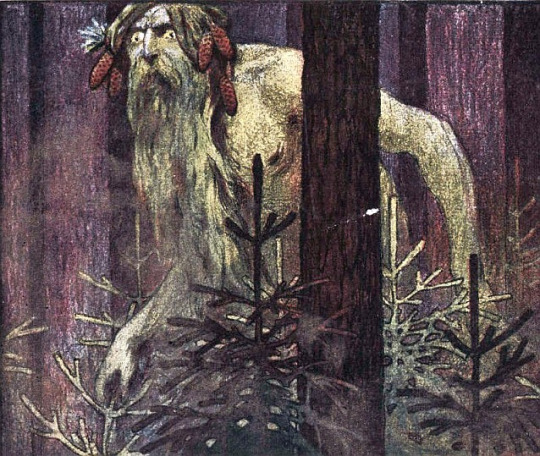
Who are you, mr. Leshy?
Leshy is a shapeshifter, able to grow as tall as the trees or shrink down to the size of a blade of grass. Sometimes he appears as a towering figure with greenish or blue skin, glowing eyes, and a long beard of moss. Other times, he takes on the form of a small, hairy old man, blending into the forest as just another part of the landscape.
He’s not just a trickster - he’s the master of all animals in the forest. Wolves and other creatures obey him without question. If a shepherd disrespects the forest or mistreats animals, Leshy might send wolves to attack his herd. Travelers who wander too deep into his domain might find themselves lost for hours, misled by paths that twist and change under Leshy’s influence.

The many faces of Leshy
In Northern Russia with its vast and dense forests, Leshy is a fearsome figure, towering and dangerous. In regions like Novgorod and Arkhangelsk, he’s seen as a powerful being with the ability to control the weather, especially during storms. His skin is sometimes described as blue, his eyes glowing eerily in the dark forest.
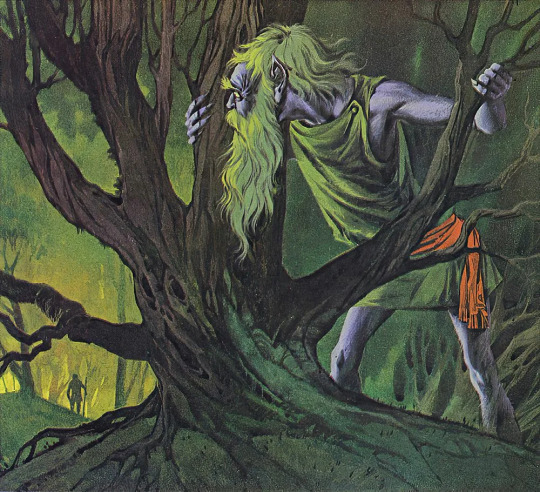
In Central Russia, in places like Tula and Yaroslavl, Leshy is more of a mischievous trickster. He often appears as an old man with a green beard and mismatched clothing. Locally, he’s known as "Muzhichok" ("little man"), a name that reflects a more familiar and less intimidating presence.
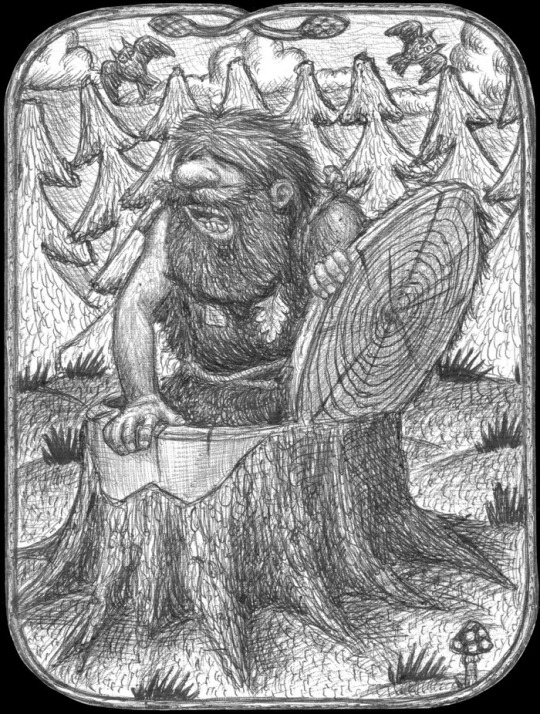
In Belarus Leshy, or "Gaun", is the protector of the ancient, untouched forests known as "puscha". He’s closely tied to the spirits of the forest, including his granddaughters, Gaevki. These beings, more benign than Leshy, protect forest animals and sometimes play harmless tricks on humans.

In Ukraine, Leshy blends with local spirits like the Polovik, becoming a guardian of both the forest and the fields. He’s less physically imposing but more cunning, often using his intelligence to outsmart humans rather than relying on brute force.
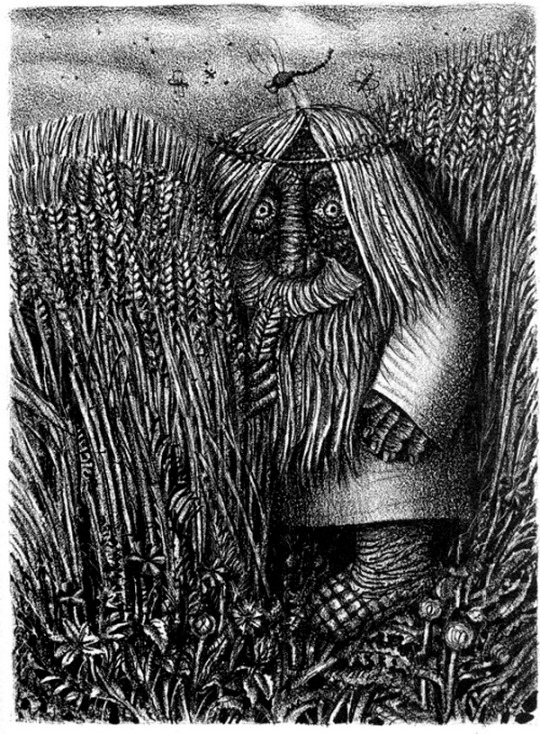
It is important to note, that this is just a short post about this spirit. There is much more to them than I would be able to post here, unfortunately. But I hope you will be motivated to learn about it!
#SlavicMythology#mythology#history#vseslavichi#mythology and folklore#nature spirits#mystical creatures#folklore#fae folk
2 notes
·
View notes
Text
Poludnitsa - not only night is dangerous
While Slavic cultures became somewhat distinct, they have common roots and, because of this, similar mythological creatures. And today we will talk about one of these creatures - Poludnitsa (Spirit of Noon).

In Slavic folklore, both noon and midnight are mystical times when the boundary between the worlds of the living and the dead thins. This is when spirits from the Nav, the shadowy realm of dark deities, undead, and alternate laws, emerge. One such spirit is Poludnitsa, known for her dangerous presence in the fields at noon, potentially leading to heat stroke or worse for those who encounter her. Poludnitsa is the embodiment of midday heat, a spirit active during the hottest part of the day. Her name is derived from the word "polden'," meaning "midday". Encounters with her are dangerous, particularly for pregnant women and children, who might fall victim to her wrath or have their children swapped. In addition, it has long been noticed that people subjected to serious heat stroke often receive some unusual abilities, while becoming somewhat out of this world.

In folklore, Poludnitsa can appear as a young blonde woman or an ancient crone, though she is most often seen in her youthful form. She typically carries a scythe, a sickle, or in later myths, a red-hot frying pan, which either protects her from the sun or scorches the fields, depending on the tale.

Meeting Poludnitsa could mean facing riddles or a dance challenge. Solving her riddles or out-dancing her might earn a reward - if one survives. Her presence and influence vary across regions, with some believing she only threatens children, while others think she endangers those who rest at noon, luring them into a deep, near-unbreakable sleep. Some believe Poludnitsa was originally a fiery spirit meant to protect fields and farmers from evil. Over time, her image changed, possibly due to Christian influences, giving her a more sinister reputation. Researchers suggest that her negative portrayal emerged only in the last centuries, hinting at an older, more benevolent role. Modern interpretations see Poludnitsa as a field spirit, warning laborers against the dangers of midday heat while protecting the crops. Her true allegiance - whether to light or darkness - remains debated.
#slavic folklore#mythology#mythology and folklore#history#vseslavichi#mythical creatures#spirits#supernatural#mystical creatures
8 notes
·
View notes
Text
The real Kitezh Grad - Mologa
The city in the photo below no longer exists. Not due to any war, pandemic, or famine - it was a man-made disaster. Maybe it didn't affect as many people as some other Soviet experiments and policies, but it is still a tragic story of how you can destroy part of your own history for mega projects.

Mologa was founded in 1149 (at least we have mentions of a settlement there during this period). During the 14th-15th centuries, it was part of the Principality of Molozhsk (the name was derived from a river rather than from a city). By the 20th century, it wasn't a big city - only around 10.000 people with 12 factories, a gymnasium 8 schools, libraries, a cinema, a post and telegraph office, a bank, a hospital, and a health center. But the region still had its value for future generations. As for the territory, that would be submerged in the future, it was densely populated (for Russia) - around 130.000 inhabitants, with some places of cultural value - 3 monasteries (one founded in the 15th century, another in the 17th, and the last one at the end of 19th), multiple manors and several churches (5 just in Mologa, 4 of which were built from stone). The region was also pretty fertile because it was situated at the bottom of an ancient lake (yep, an interesting fact considering what happened to it later). It wasn't rich, but every year Mologa allowed up to seven thousand ships from the Lower Volga provinces to pass through its wharves.



It all started in 1932 when it was decided to build the Srednevolzhskaya hydroelectric complex. At first, only a small part of the region would be flooded - but the more you have the more you want to have. However, the construction organisers, having calculated everything, decided that if the level was increased by 4 m, the capacity of the plant would increase from 220 to 340 MW. It required a doubling of the land area to be submerged. Everything was decided by profit. The population was notified about the resettlement. The townspeople were transported out of Mologa for 4 years until the flooding began, with little to no belongings. Partially, they were compensated, and they also were employed at their new places of living.
But there were a lot of animals - both domesticated and wild - and the region had forests. What happened to them? Well, some domesticated animals were taken by their owners, while others died due to starvation or during flooding. The same fate awaited wild animals - most of them died during flooding. Trees were cut and, most of them were left there, creating obstructions on Volga and on the newly created reservoir. Here are some photos of Mologa.



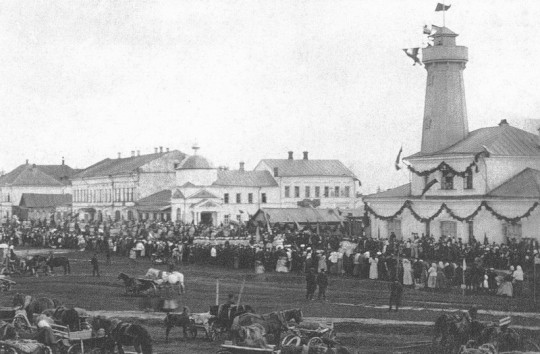
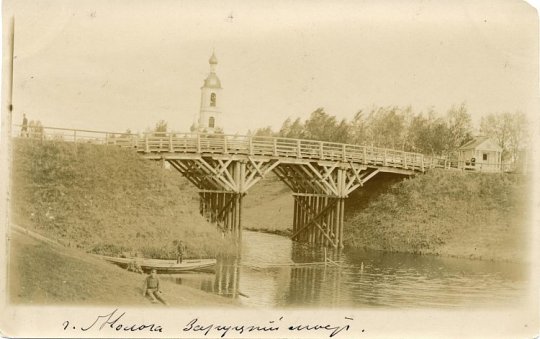
The culture of Mologa was similar to that of Yaroslavl Governorate, with some small differences - there were several unique holidays, and some differences in celebrations of major ones, it was also overall more rural and better maintained some older aspects of early Russian culture. But the main loss came from the displacement of people - they lost connection with their roots. And I mean not only their graves or houses but items that were inherited through generations - you couldn't take that much with you considering when and how the resettlement happened.
Why is this relevant? One of the key themes I want to explore in my story is the contrast between modern russian culture, which is more soviet than one might thing, and the older russian traditions. My goal is to show this difference. Throughout the story, characters embark on personal journeys to reconnect with their roots in various regions, seeking to understand their connections to the people who lived long before them. One character has ancestors from Lukovec, a settlement in the northern part of the flooded region.
Just a reminder - every culture that was under Soviet rule suffered one way or another. Creating Homo Sovieticus was the goal.
1 note
·
View note
Text
Solyanka - still not as salty as a losing gamer
Food is an important part of any culture. You can tell a lot about culture based on their beverages and cuisine. And in Slavic/Russian cuisine several things can easily prove it. We have (had?) a lot of fish dishes (a huge number of rivers), salting (harsher seasons), soups (again, harsher seasons), and the usual - different pastries (though this is pretty common). I could delve deeper into each category talking about kolach, okroshka, rassolnik, levashnik, kalja, oladyi, borsh, kurnik, shchi, ukha, botvinia, etc. But that wouldn't be really interesting if you would just get information without a recipe, wouldn't it?

So today we will focus on solyanka. There are actually two solyankas - one is a soup with pickles another is a main dish with cabbage. In this post, I will focus on the former - solyanka the soup!

This dish formed in the 15th or 17th century and was, basically, peasant food. It was a simple thick chowder with meat, cabbage, onion, and pickles. The current recipe appeared only in the 19th century with some new and several expensive ingredients - olives, capers, lemon, bread kvass, and salted or pickled mushrooms. There was a bit of a hassle among culinary scholars about why it got its name - either as a salty dish (solyanka is literally salt with a cute suffix), or as a denotation that it came from a rural area (russian word "selskiy" means rural, so they assumed that it was butchered word for "selyanka"). But most names of the dishes in Russian cuisine usually indicate the way a dish was prepared or consumed. So, how do you make a great solyanka?

This recipe can be used with both home-cooked broth and pre-cooked one. So, what do you need for a fancy solyanka? First, ingredients for the soup:
400 grams of beef - I use brisket, but you can use it shoulder or even shank (if you want to use it for a broth too).
200 grams of smoked sausages
~400 ml of grated tomatoes (I used 350 ml)
200 grams of onions
150 grams of carrot (to make it heartier)
40 grams of butter
120 grams of pickled cucumbers
100 grams of seedless black olives (or you can add another 100 grams of pickled cucumbers for that Peasant's Feast After Great Lent vibe)
200 ml of pickled cucumber brine
50 ml of olive brine (or replace with the same amount of pickled cucumber brine)
A bunch of dill greens
1-2 pcs of laurel leaf
2-3 pcs of peppercorn pepper
2-3 pcs of black pepper peas
sour cream to server
And now ingredients for the broth (you can just buy precooked broth if you want - I won't judge):
~2 litres of water
600 grams of beef bones (or shank if you will use it for both broth and soup)
150 grams of carrot
200 grams of onion
A pinch of dried thyme
5-6 pcs of peppercorn pepper
5-6 pcs of black pepper peas
2 leaves of laurel leaf

Part I - The Broth
I think it is the most important part of solyanka, so I don't slack here (you can though! If you are not obsessed with cooking, using precooked broth is fine). So, if you are going to cook broth, do this:
Wash the onions, peel them, and cut them in half.;
Wash the carrots, peel them, and cut them into 2-3 pieces each;
Rinse the beef bones under running water.;
Place the bones in a pot with approximately 2 liters of water and bring to a boil;
Once boiling, reduce the heat to low and simmer for 1.5 to 2 hours, skimming off any foam that forms;
Add the onions, carrots, thyme, and peppers 30-40 minutes before the broth is done;
Add the bay leaf 5-10 minutes before the end of cooking to avoid bitterness;
After the broth is ready, remove vegetables and meat. If you will use meat further, then cut it into pieces and follow the recipe



Part II - Solyanka
Now to the main part of the soup! You should do it after the broth is ready, or 10 mins before this because we will need to mix everything.
Peel the onions, and cut them into thin half-rings.
Peel the carrots, then shred them.
Heat a thick-bottomed frying pan and sauté the onions with carrots in butter until they soften.
Once the onions soften, add grated tomatoes and cook for another 5-7 mins.
Cut pickled cucumbers into cubes (I prefer to cut them into smaller ones, but medium-sized ones are fine too).
In a separate dry frying pan, sauté the cubed cucumbers with a small amount of broth (~200 ml) until they become pulpy, then add them to the sautéed onions and carrots.
Pour the cucumber brine into a saucepan, and bring it to a boil. Combine it with the meat broth and bring it all to a boil.
Cut smoked sausages and beef. Fry them in a pan for 5-10 minutes.
Add everything (sautéed onions with carrots and pickled cucumbers, meat, sausages, and olives - if you decided to use them) to the boiling broth with cucumber brine. Bring it to a boil and cook for another 20 mins.
After that add brine from the olives (if you decided to use it), peppers, and bay leaf. Cook for another 10 minutes.
Before serving, remove the bay leaf, taste for salt, and adjust if necessary. Let the soup stay for 10 minutes under the lid. Serve in a bowl with sour cream and a sprinkle of dill.



And that's it! If you want to make it simple - just follow Part II and you will be fine. Even if you cook it in simple water it will taste somewhat good. Not as good as if you used a broth, mind you. Also, there will be another post soon, because I slacked off yesterday. Just for funsies (if you can call a relocation of nearly 130.000 people a funsy).
#cooking#recipes#history#slavic cuisine#russian cuisine#long reads#traditionalrecipes#soup#soup recipe#heartysoup#easterneuropeancuisine#home cooking#homecookedmeals#cooking at home#deliciouseats#is this enough tags algorithm?!
0 notes
Text
Tbh if Minotaur is a furry, then Gamayun is a feathery.

Question for the mythology nerds, do Minotaurs count as furries? I just drew a Minotaur and my friend is asking whether it counts as furry art.
67 notes
·
View notes
Text
Vseslav of Polotsk: The Enigmatic Prince of Ancient Rus
Vseslav of Polotsk, known as "Vseslav the Sorcerer" or "Vseslav Bryachislavich," is one of the many Rurikoviches. Born around 1039, he was the son of Bryachislav of Polotsk and ruled the Principality of Polotsk for 55 years. Vseslav's life and reign were marked by both typical and unusual elements of princely rule during the era of Kyivan Rus.

Vseslav inherited the throne of Polotsk around 1044, a region located along the Western Dvina River, which was vital for trade routes connecting the Baltic and the Byzantine Empire. Polotsk was one of the principalities within the loose federation known as Kyivan Rus.

Vseslav's epithet "the Sorcerer" is one of the more colorful aspects of his legacy. Medieval chronicles, including the Russian Primary Chronicle, attribute his nickname to his reputed magical abilities. There are basically two explanations as to why he got that nickname: first attributes it to a birthmark, and second - to a caul that he covered him when he was born and which he wore as an amulet. His contemporaries believed he could transform into a wolf and traverse great distances at incredible speeds.
Like many rulers of his time, Vseslav was both a warrior and a politician. His reign was characterized by continuous conflicts with neighboring principalities. In 1067, he launched a bold attack on Novgorod. Capturing Novgorod was a significant achievement, although his hold on the city was brief. When he went to discuss peace with his enemies - 3 sons of Yaroslav the Wise - he was captured and thrown into a prison in Kyiv. But, later, those sons were defeated by the Cumans. So people in Kyiv demanded that Vseslav should be freed and given control of their military forces. At this point, some of the advisors suggested that Vseslav should be killed, but they were out of time - soon a revolt happened and Vseslav was freed. He became a Grand Duke of Kyiv for seven months.
Despite his martial pursuits, Vseslav also contributed to the cultural and spiritual life of Polotsk. He founded the Cathedral of St. Sophia in Polotsk, modeled after the great St. Sophia Cathedral in Kyiv, symbolizing Polotsk's importance and his ambition to elevate the city’s status. At least five cities were founded during his reign. Polotsk Principality became one of the strongest Rus principalities.

Vseslav's legacy is preserved in various sources, from the Russian Primary Chronicle to Belarusian, Ukrainian, and Russian folklore. In Belarusian culture, Vseslav is often celebrated as a national hero, a symbol of the country's deep historical roots and its early medieval statehood.
And this is just a short article about him, yeah. He isn't the most well-researched of the Rus princes, but there is still enough information to learn more about him if you desire.
3 notes
·
View notes